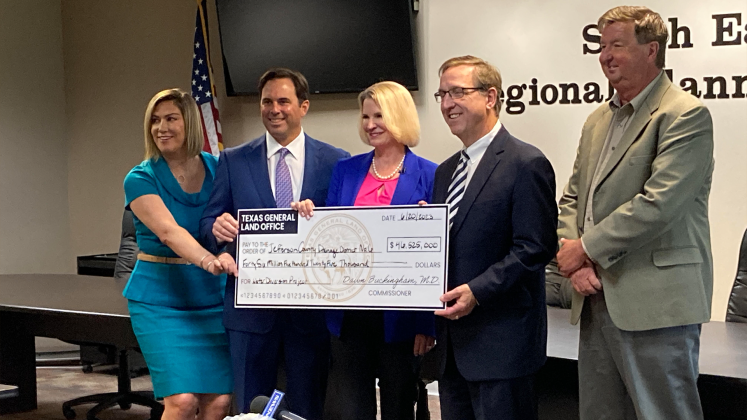June 20, Texas Land Commissioner Dawn Buckingham arrived in Beaumont to announce the Texas General Land Office (GLO) approval of more than $128 million in regional mitigation funds for 19 federally eligible infrastructure projects to improve streets, as well as water and drainage facilities. The plan includes $46.525 million allocated to the Jefferson County Drainage District No. 6 (DD6) for the Corley Diversion Project.
At the announcement, Buckingham presented a check for $46,525,000 to the local recipients during a meeting held at the South East Texas Regional Planning Commission Building.
“I’ve had family in this area for the past 30 years, and I’m aware how this area floods, how they are affected by hurricanes and how important these flood mitigations projects are,” Buckingham said. “We love to bring dollars and resources to your community so you can grow and thrive.”
The GLO commissioner said this allocation of funding was “a little bit unique,” due to community and elected leaders allowing the process to be directly attributed to the drainage district.
“It turned out to be a little bit of an experiment that worked out really well for us and helped us get these dollars,” said Buckingham.
Doug S. Canant Jr., interim CEO for DD6, said the Corley Diversion Project includes large box culverts under city streets in Beaumont.
“Right now, we’re looking at two strings of 8-foot high by 10-foot wide box culverts under city streets that will start at the Port of Beaumont property by the Navy ships, then make its way up Blanchette and down a city street, across Martin Luther King Jr. Parkway, across a couple of railroad tracks and end up in the CartwrightCorley area of Beaumont,” Canant explained. “It will help relieve water that now drains through there and redirect that water and take it to the river.”
The drainage district leader said staff has checked all the elevations to ensure the project has zero adverse affects to anyone along the route.
“It will only have positive impact for everyone along the route,” added Canant.
Jefferson County Judge Jeff Branick said that approximately 95% of Jefferson County, along with parts of Chambers and Liberty counties, drains into Taylor’s Bayou, which will see relief with the pending DD6 project.
“Jefferson County Drainage District No. 6 has done a good job over the last 25 years with the need for diversion projects,” Branick said. “The water goes directly to the Intercostal Waterway.”
Branick said the county’s long-range plan is for water from the city of Beaumont and the northwest part of the county to flow into the Neches River.
“The Neches River has an unlimited capacity,” added Branick. “The Neches Waterway is responsible for over 60% of fresh water into the Gulf of Mexico from Texas comes from the Sabine-Neches Waterway.”
Other cities and counties receiving regional mitigation funds include the cities of Aransas Pass, Coldspring, Corrigan, Dayton, Freeport, Hitchcock, Iowa Colony, Katy, La Marque, Palacios, Pearland, Richwood, Rosenberg, Shepherd, Texas City, and the counties of Liberty and Waller. Through the Regional Mitigation Program, the GLO enabled local prioritization, which will have an anticipated beneficial impact across multiple regions. However, Commissioner Buckingham worries, “HUD is misbehaving.”
According to Buckingham’s office, the GLO allocated $1,166,997,000 in Community Development Block Grant Mitigation (CDBG-MIT) funds from the U.S. Department of Housing and Urban Development (HUD) for the Regional Mitigation Program to reduce the risks and impacts of future natural disasters. Each Council of Government (COG) with HUD-designated eligible counties developed a method of distribution (MOD) for allocation of funds to units of local governments.
Each COG developed their MOD through extensive public participation; and HUD has objections.
“They are trying to come after these dollars with unfair accusations, even though we have met their entire process,” Buckingham said. “This process was approved by (HUD) with every step along the way.
“They are trying to take your dollars back. We are going to stand in that fire and fight for your COG against what they are doing.”
HUD defines mitigation as activities that increase resilience to disasters and reduce or eliminate the long-term risk of loss of life, injury, damage to and loss of property, and suffering and hardship, by lessening the impact of future disasters. HUD requires that at least 50% of total funds be used for activities benefiting low- to moderate-income (LMI) persons.


